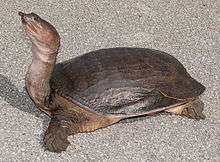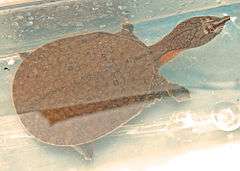Florida softshell turtle
| Florida softshell turtle | |
|---|---|
 | |
| Scientific classification | |
| Kingdom: | Animalia |
| Phylum: | Chordata |
| Subphylum: | Vertebrata |
| Class: | Reptilia |
| Order: | Testudines |
| Suborder: | Cryptodira |
| Family: | Trionychidae |
| Subfamily: | Trionychinae |
| Genus: | Apalone |
| Species: | A. ferox |
| Binomial name | |
| Apalone ferox (Schneider, 1783) | |
| Synonyms[2] | |
| |
.jpg)
The Florida softshell turtle (Apalone ferox) is a species of softshell turtle native to the Southeastern United States.
Geographic range
A. ferox is found primarily in the state of Florida, but it also ranges to southern sections of South Carolina, Georgia, Alabama, and Texas.[3]
Description
The Florida softshell turtle typically has a dark brown to olive green, leathery carapace with a white or cream-colored underside,[4] which visually conceals young turtles from potential predators.[5] It has a long neck and an elongated head with a long snorkel-like nose. It is the largest softshell turtle in North America and one of the largest freshwater turtles there, as well (only the alligator snapping turtle averages considerably larger), reaching about 15 to 76 cm (5.9 to 29.9 in) in length.[4] The female is larger, with the average male reaching only about 35 cm (14 in). The female can weigh up to 20 kg (44 lb), with the record weight documented at 43.6 kg (96 lb).[1][6] Nesting adult females were found to average 6.65 kg (14.7 lb) in weight, and measure 40.1 cm (15.8 in) in carapace length and 30.1 cm (11.9 in) in plastron length.[7] In comparison, 127 males were found to average 2.68 kg (5.9 lb) in weight and measure 22.75 cm (8.96 in) in plastron length.[6] In comparison, the juvenile is olive-yellow with grey spots and yellow lines. Also, yellow and orange markings are found on the head and the plastron is gray. The markings disappear or fade as it ages.[4]
Behavior
A. ferox is almost entirely aquatic, only emerging from the water to bask or to lay eggs.[4] It prefers the still waters of ponds, streams, lakes, and swamps. Like all softshells, it is very fast-moving in water and on land.[4] This species is carnivorous, consuming fish, insects, crustaceans, and molluscs. It may also scavenge.[1]
Ecology
Alligators have been known to prey on the adults of A. ferox. Raptors may take juveniles. Nest predators include the fish crow, foxes, raccoons, and skunks.[1]
References
- 1 2 3 4 van Dijk, P.P. (2011). Apalone ferox. In: IUCN 2013. IUCN Red List of Threatened Species. Version 2013.1. Downloaded on 21 July 2013.
- ↑ Fritz, U.; Havaš, P. (2007). "Checklist of Chelonians of the World". Vertebrate Zoology. 57 (2): 305–306. ISSN 1864-5755. Archived from the original (PDF) on 2010-12-17. Retrieved 29 May 2012.
- ↑ Apalone ferox (Schneider, 1783). USGS.
- 1 2 3 4 5 Apalone. www.tortoise.org
- ↑ "Heron tries to swallow turtle for dinner". Daily Telegraph. 18 Dec 2009.
- 1 2 Meylan, P.A.; Schuler, R.; Moler, P. (2002). "Spermatogenic cycle of the Florida softshell turtle, Apalone ferox ". Copeia 2002 (3): 779-786.
- ↑ Iverson, J.B.; Moler, P.E. (1997). "The female reproductive cycle of the Florida softshell turtle (Apalone ferox)". Journal of Herpetology 31 (3): 399-409.
Further reading
- Behler, J.L.; King, F.W. (1979). The Audubon Society Field Guide to North AmericanReptiles and Amphibians. New York: Alfred A. Knopf. 743 pp. ISBN 0-394-50824-6. (Trionyx ferox, pp. 483-484 + Plates 272, 273).
- Boulenger, G.A. (1889). Catalogue of the Chelonians, Rhynchocephalians, and Crocodiles in the British Museum (Natural History). New Edition. London: Trustees of the British Museum (Natural History). (Taylor and Francis, printers). x + 311 pp. + Plates I-III. (Trionyx ferox, p. 259).
- Conant, R. (1975). A Field Guide to Reptiles and Amphibians of Eastern and Central North America, Second Edition. Boston: Houghton Mifflin. xviii + 429 pp. + Plates 1-48. ISBN 0-395-19979-4 (hardcover), ISBN 0-395-19977-8 (paperback). (Trionyx ferox, p. 81 + Plates 6, 12 + Map 35).
- Schneider, J.G. (1783). Allgemeine Naturgeschichte der Schildkröten, nebst einem systematischen Verzeichnisse der einzelnen Arten und zwey Kupfern ". Leipzig: J.G. Müller. xlviii + 364 pp. + corrigenda. (Testudo ferox, new species, pp. 330-334). (in German and Latin).
- Smith, H.M.; Brodie, E.D., Jr. (1982). Reptiles of North America: A Guide to Field Identification. New York: Golden Press. 240 pp. ISBN 0-307-47009-1 (hardcover), ISBN 0-307-13666-3 (paperback). (Trionyx ferox, pp. 32-33).
External links
- Apalone ferox, The Reptile Database.
| Wikimedia Commons has media related to Apalone ferox. |

